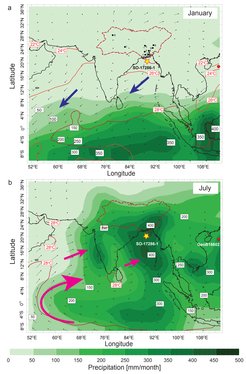Paleoclimate and Environment Changes in Tropic Monsoon Regions

Addressing and anticipating future tropical monsoon changes under continuing global warming is of critical importance for the food security and socioeconomic well-being of 40% of the world’s population. Despite the far-reaching consequences, predicting tropical monsoon behavior under climate warming scenarios remains a key challenge for both global and regional climate models. This knowledge gap limits our understanding of the extent to which ISM intensity responds to rapidly changing climatic factors—such as rising sea surface temperature (SST), elevated atmospheric greenhouse gas (GHG) concentrations, changing vegetation cover, and decreasing ice sheets and sea ice cover—and their interactive dynamics in a warming climate.
We use compound specific stable isotope analyses of terrestrial biomarkers, namely leaf wax n-alkanes from marine sediments, to reconstruct changes in monsoon rainfall and vegetation in East Africa and South Asia. In addition, we also employ a suite of inorganic and organic proxies, which include foraminifera Mg/Ca ratio and d18O, and alkenone unsaturation index UK’37 to reconstruct past oceanographic conditions (e.g. sea surface temperature and salinity changes) in the Indian Ocean, which exert important influence on the adjacent continental hydroclimate. Besides generating new climate records, we have also collaborated with climate modelers to gain a deeper understanding of the mechanisms controlling climatic and oceanographic conditions. These paleoclimate reconstructions also provide regional climatic and environmental context for the information relating to demography and human social changes.











